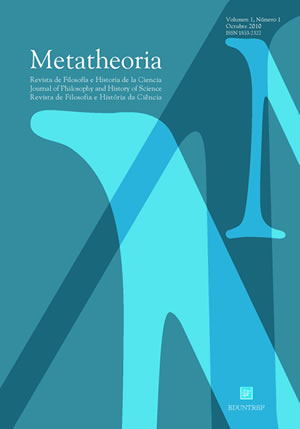La naturaleza y estructura de las teorías científicas
DOI:
https://doi.org/10.48160/18532330me1.32Palavras-chave:
teorías científicas, estructura, semántica, modelosResumo
En filosofía de la ciencia, dos cuestiones resultan centrales en la discusión acerca de la naturaleza de la ciencia empírica: 1) ¿qué es una teoría (científica)?, es decir, ¿cómo está constituida y cómo funciona? y 2) ¿cómo se relaciona una teoría con su correspondiente base experiencial? Para tratar estas dos cuestiones, la moderna filosofía de la ciencia ha desarrollado varios “modelos” (metateóricos) sobre la naturaleza y el funcionamiento de las teorías científicas. Algunos aspectos de estos modelos son ampliamente aceptados por la comunidad de filósofos de la ciencia, mientras que otros son todavía discutidos de manera bastante controvertida. En este trabajo, consideraremos ambos tipos de aspectos. En particular, analizaremos cómo se determina el significado de los conceptos teóricos, la construcción axiomática de una teoría científica, la idea de las concepciones sobre la construcción de modelos como puente entre la teoría y la experiencia, la tesis semántica holista de la ciencia, la cuestión acerca de la verdad de las teorías científicas y, finalmente, la estructura jerárquica de las teorías.
Referências
Balzer, W. and C.U. Moulines (1981), “Die Grundstruktur der klassischen Partikelmechanik und ihre Spezialisierungen“, Zeitschrift für Naturforschung 36a: 600-608.
Balzer, W., Moulines, C.U. and J.D. Sneed (1987), An Architectonic for Science. The Structur-alist Program, Dordrecht: Reidel.
Balzer, W., Moulines, C.U. and J.D. Sneed (2000), Structuralist Knowledge Representations: Paradigmatic Examples, Amsterdam: Rodopi.
Carnap, R. (1952), The Continuum of Inductive Methods, Chicago: The University of Chicago Press.
Carnap, R. and R. Jeffrey (1971), Studies in Inductive Logic and Probability, Berkeley: Univer-sity of California Press.
Díez, J.A. (1997), “A Hundred Years of Numbers. An Historical Introduction to Measure-ment Theory. Part I: The Formation Period“, Studies in History and Philosophy of Science28(1): 167-181.
Díez, J.A. (1997), “A Hundred Years of Numbers. An Historical Introduction to Measure-ment Theory. Part I: Suppes and the Mature Theory“, Studies in History and Philosophy of Science 28(2): 237-265.
Díez, J.A. and C.U. Moulines (1999), Fundamentos de filosofía de la ciencia, Barcelona: Ariel, 2da edición revisada.
Duhem, P. ([1906]1981), La théorie physique, son objet, sa structure, Paris: Vrin.
Henkin, L., Suppes, P. and A. Tarski (eds.)(1959), The Axiomatic Method, Amsterdam, North-Holland.
Krantz, D., Luce, D., Suppes, P. and A. Tversky (1971), Foundations of Measurement, I, New York: Academic Press.
Kuhn, T.S. (1970), The Structure of Scientific Revolutions, Chicago. The University of Chicago Press, 2nd enlarged edition.
Kyburg, H.E. (1968), Philosophy of Science. A Formal Approach, New York: Macmillan.
Moulines, C.U. (2006), La philosophie des sciences. L’invention d’une discipline, Paris: Editions de la Rue d’Ulm, 2006.
Moulines, C.U. and J.A. Díez (1994), “Theories as Nets: Combinatorial Measurement Theo-ry”, in Humphreys, P. (ed.), Patrick Suppes, Mathematical Philosopher, Dordrecht: Kluwer, pp. 275-297.
Nagel, E. (1961), The Structure of Science, New York: Harcourt.
Popper, K.R. (1934), Logik der Forschung, Vienna: J. Springer. (English revised and enlarged edition: The Logic of Scientific Discovery, London: Hutchinson, 1958.)
Popper, K.R. (1972), Objective Knowledge, Oxford: Clarendon Press.
Quine, W.V.O. (1953), From a Logical Point of View, New York: Harper and Rowe.
Stegmüller, W. (1970), Theorie und Erfahrung, Berlin-Heidelberg: Springer.
Stegmüller, W. (1973), Theorienstrukturen und Theoriendynamik, Berlin-Heidelberg: Springer.
Stegmüller, W. (1974), Personelle und statistische Wahrscheinlichkeit, Berlin-Heidelberg: Springer.
Suppe, F. (1989), The Semantic Conception of Theories and Scientific Realism, Chicago: University of Illinois Press.
Suppes, P. (1957), Introduction to Logic, New York: Van Nostrand.
Suppes, P. (1962), “Models of Data”, in Nagel, E., Suppes, P. and A. Tarski (eds.), Logic, Methodology and Philosophy of Science. Proceedings of the 1960 International Congress, Stan-ford: Stanford University Press, pp. 252-261.
Tarski, A. (1956), Logic, Semantics, Metamathematics, Papers from 1923 to 1938, Oxford: Clarendon Press, Oxford.
Van Fraassen, B. (1980), The Scientific Image, Oxford: Clarendon Press.
Downloads
Publicado
Como Citar
Edição
Seção
Licença
Copyright (c) 2010 Metatheoria – Revista de Filosofia e História da CiênciaOs documentos publicados aqui são regidos pelos critérios de licenciamento Creative Commons Argentina.Atribución - No Comercial - Sin Obra Derivada 2.5





